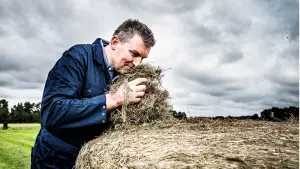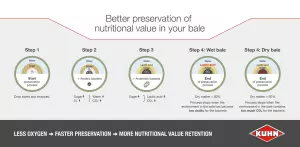
The preservation process that takes place inside round bale silage has a degree of complexity. But once you understand the basic principles, it will assist in the decision making concerning binding and wrapping bales. In simple terms: the less oxygen, the faster the preservation and the more nutritional value is retained.

Step 1:
Every bale partly consists of sugar, proteins, water and oxygen. The preservation process starts and is carried out by bacteria which are naturally present in the bale.
Step 2:
First the aerobic bacteria get to work, these are bacteria that need oxygen. They convert the sugars with the oxygen into CO2 and water. This means loss of energy - read: sugars - and dry matter. This process continues until the oxygen is consumed.
Step 3:
Then the anaerobic bacteria take over that don't need oxygen. They also use sugars, but convert them into lactic acid and CO2. This process lowers the pH and increases the CO2 concentration.
Step 4:
Ultimately, the preservation stops, depending on the dry matter content. It stops either on the basis of the pH level, in case of a dry matter lower than 50%, so relatively wet bales. Or it stops based on the concentration of CO2, in case of a dry matter higher than 50%, so relatively dry bales. Once the preservation process has stopped, you have a very stable bale that can be stored for months and months.
So the less oxygen you trap in the bale during ensiling, the faster the preservation and the more nutritional value is retained. Oxygen ingress during storage, for example by deformation of the bale or damage to the film, should also be prevented. Otherwise the preservation process and thus loss of nutritional value starts all over again.
Film bound bales promote consistent crop preservation
The KUHN Baling Test (2021) showed that the preservation process went better in film bound bales than in net bound bales.
